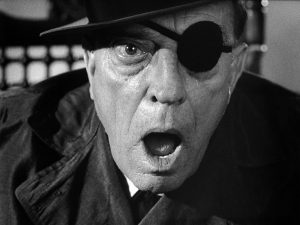
The iconic beginning of Film (directed and written by Samual Beckett, played by Buster Keaton)
Could it be that Film is perhaps easier to interpret than most of Beckett’s work owing to the fact that there is also a sort of ‘manual’ for its understanding? I am, of course, talking about its screenplay written by Beckett himself. Alas, the situation is not that simple. We cannot equate the screenplay to the film for obvious technical/terminological reasons on the one hand, but also because the final version of Film itself came out somewhat differently than intended.
In the general introduction to his script, Beckett states that the “[c]limate of [the] film [is] comic and unreal” (163). Both of these propositions seem to be unrealized. For one thing, the medium of film is essentially–by nature–realistic, as it can record our material world in minuscule detail. For a writer like Beckett, who was new to the medium of film, or indeed for anyone this would have been a challenge. As for the comic part, most of the intended comedy of Film ultimately falls flat which could be explained in several ways. It may be that the mere melancholic mood of the movie does not allow us to laugh. It might also be the case that because the subject matter is so convoluted that we have to try hard to keep up with it, thus the comic parts simply go right over our heads. It may as well be due to the fact that we as film viewers (even the audience in the 60’s) are used to a certain level of advanced technology, such as the use of colour and sound, which are merely not applied by Beckett.

Buster Keaton and Samuel Beckett walk into a movie studio
What I set out to examine in my analysis was how the film’s protagonist “O” seeks non-existence in accordance with Berkeley’s idea of esse est percipi. By constantly hiding from perception, “O” exists calmly in his supposed ‘angle of immunity’ constantly pursuing non-existence. This calmness is naturally deceptive since “O” does not cease to be perceived. Although he does not perceive his perceivers (the camera referred to as “E” and us, the audience), it does not mean that he cannot be seen. This act is reminiscent of the peek-a-boo game people play with babies where the baby is surprised by the adult suddenly appearing from their ‘hiding place’, which is astonishing for infants because they cannot understand object permanence. Similarly, (he is showing his back to the camera) that does not mean the perceiver will cease to exist or cease to perceive.

Buster Keaton as “O”
Throughout the film, “O” struggles to escape perception; he hides his face with a hat, his back is to the camera at all times, and he flees to a room where he is alone and where he hastily tries to get rid of everything by which he could be seen. “All extraneous perception is suppressed, animal, human, divine […]”(163). First, he closes the blinds on the window and pulls the curtains across. After this, he seemingly eliminates his self-perception by covering the mirror. Then, he puts the cat and the dog out, albeit with some difficulty and here a running gag ensues where “O” has to put the animals out of the room repeatedly because with each door opening one of them sneaks back in. After this episode “O” tears up the picture of “the face of God the Father” obliterate the final and ultimate perceiver, thus extracting God from Berkeley’s theory.
Bibliography:
- Collected shorter plays / Samuel Beckett London ; Boston : Faber-Faber, 1984. 316 p.
- Samuel Beckett, ‘Film’, in Complete Dramatic Works, (London: Faber, 1990), 321-334, p. 323.
Source of images:
- https://i.pinimg.com/564x/cc/bc/41/ccbc4152663aef46d9ec2cfed16e2219–samuel-beckett-schneider.jpg
- https://wfdd-live.s3.amazonaws.com/styles/slideshow/s3/images/slideshow/Buster-Keaton-And-Samuel-Beckett-Walk-Into-A-Movie-Studio–473536459-1460295906.jpg?itok=EHLFD6dP
- https://media.npr.org/assets/img/2016/04/08/notfilm000-76d403660aa76f6e72f6eec5914aeb690f4583aa-s900-c85.jpg

